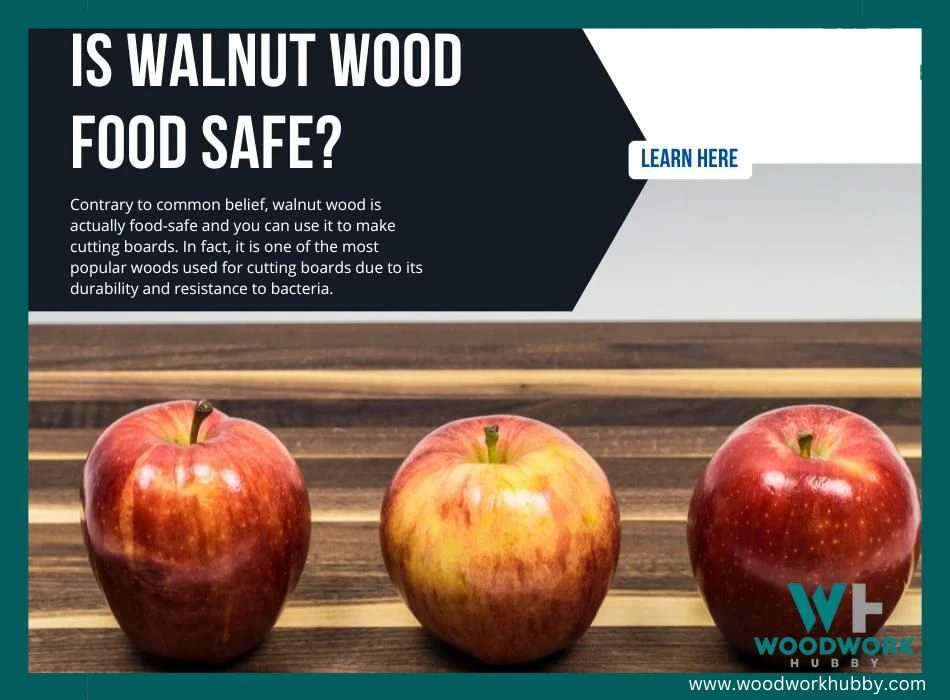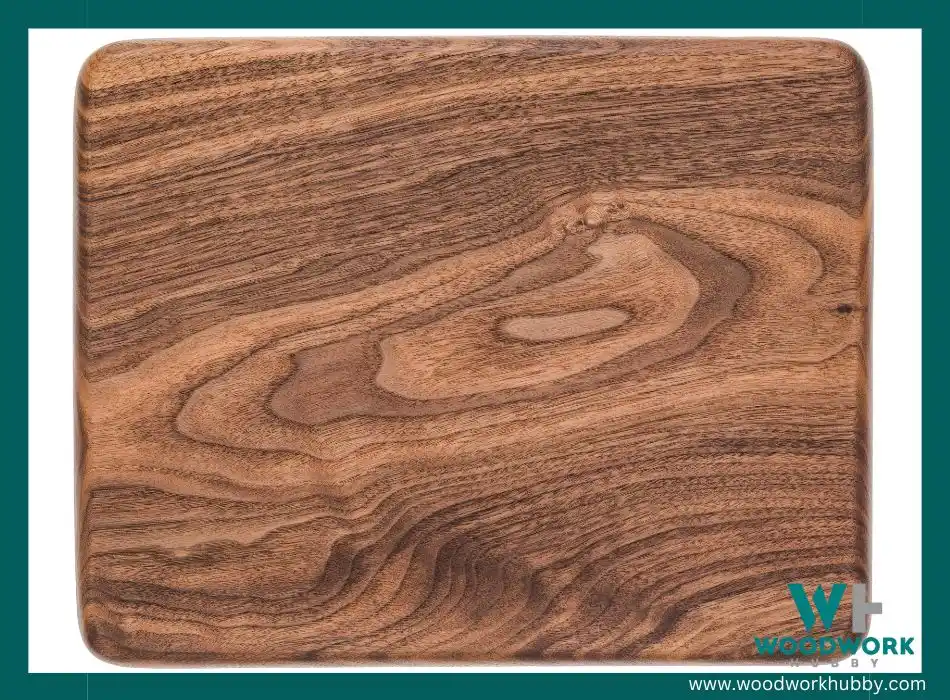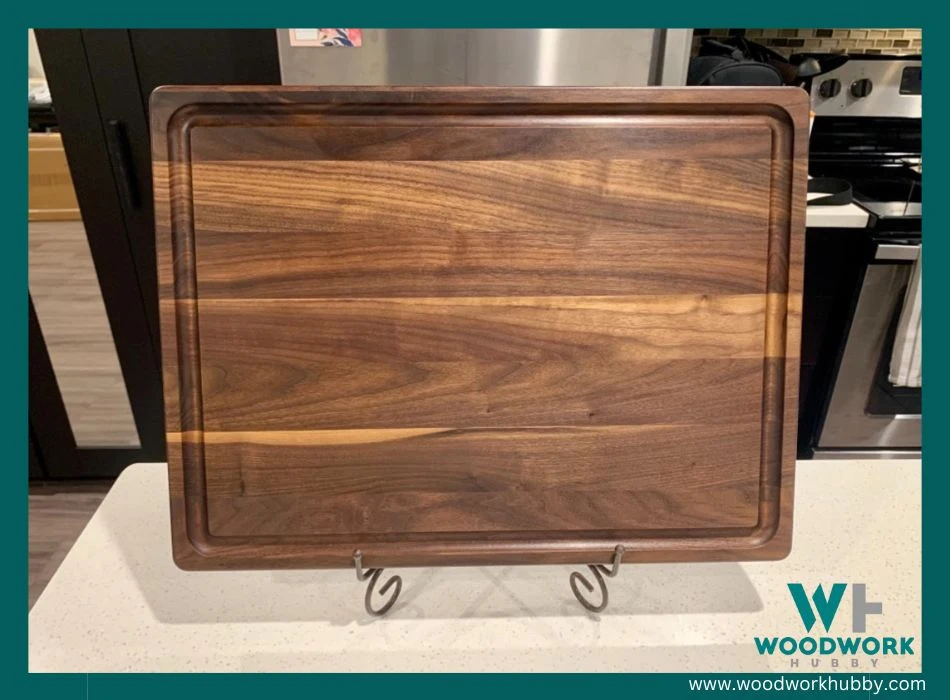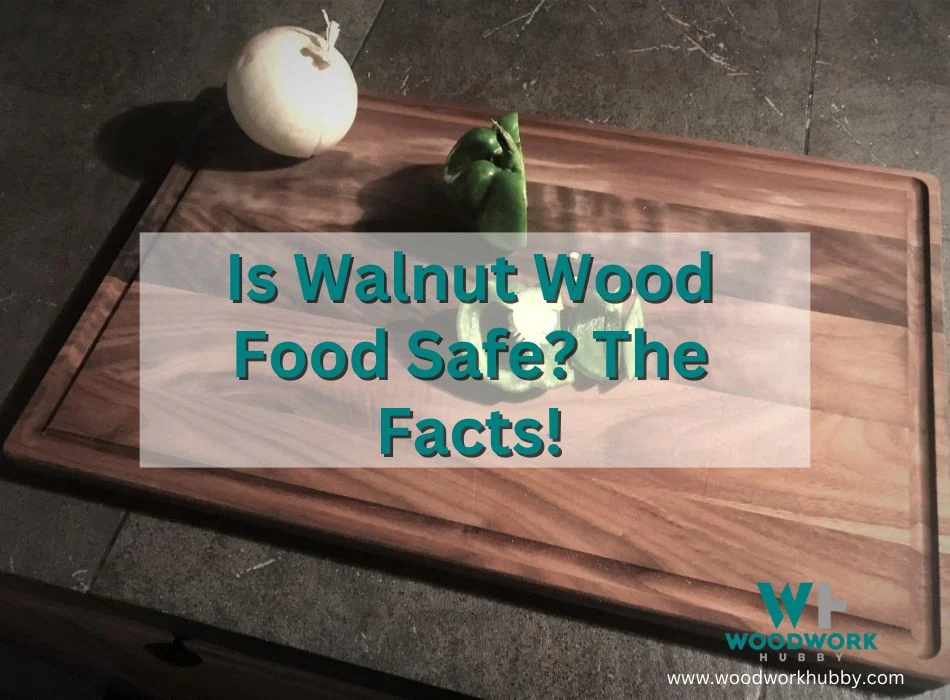If you are a fan of using wooden cutting boards in your kitchen, you may be wondering if walnut wood is food-safe. In this blog post you will find out, is walnut wood food safe. I will give you straight facts and provide you with some information that will help you make an informed decision about whether or not to use walnut wood cutting boards in your kitchen.
Contrary to common belief, walnut wood is actually food-safe and you can use it to make cutting boards. In fact, it is one of the most popular woods used for cutting boards due to its durability and resistance to bacteria. Walnut wood has also been used to make other kitchen items such as bowls and utensils for centuries.
Read on as I dive deeper into the topic of walnut wood and its safety for use in the kitchen. I will also provide some tips on how to properly care for your walnut cutting board to ensure that it lasts for many years to come.
Is Walnut Wood Food Safe?

Walnut is among the best hardwood options for kitchenware, as it is naturally antibacterial and resistant to bacteria. So yes, walnut wood is food safe.
There has always been a concern that walnut wood cannot be used for cutting boards or other kitchenware because it is toxic. However, this is not the case.
Walnut wood is actually a very popular material for cutting boards and other kitchen items due to its durability, resistance to bacteria, and beautiful grain pattern.
The only part of the walnut tree that contains toxins is the roots. The roots contain a toxin called juglone, which is a species-specific toxin. Juglone is toxic to other plant species. The walnut plant uses the toxin to outcompete other plants for resources. However, the toxin is not present in the wood of the walnut tree.
So if you have been wondering if walnut wood is food safe, the answer is yes. Walnut wood is an excellent material for cutting boards and other kitchen items.
Is Walnut Toxic For Cutting Boards?
Walnut has been used for centuries to make cutting boards and other kitchen items. It is 100% food-safe, which means it is not toxic for cutting boards.

As I mentioned earlier, walnut wood is among the most preferable hardwoods for kitchenware due to its durability, resistance to bacteria, and beautiful grain pattern. A simple “walnut cutting boards” search on Google will reveal several types of products made from walnut wood, ranging from simple cutting boards to more intricate designs.
You may still be wondering, “What if I am allergic to walnuts? Can I still use walnut cutting boards?” Yes, you can still use walnut cutting boards even if you have an allergy to the tree nut. The allergen is present in the tree nut, not in the wood. So, even if you have an allergy to tree nuts, you can still safely use walnut cutting boards.
And in any case, you are not going to be sanding the cutting board or letting kids chew on its corners, right? So, even if there were any toxins present in the wood, they would not pose a threat to you or your family.
Can You Use Black Walnut Wood For A Cutting Board?
While black walnut contains the highest concentration of juglone, the wood is still safe for cutting boards. Black walnut is a beautiful hardwood with a rich, dark color that is perfect for making cutting boards and other kitchen items.

The juglone in black walnut is mainly found in the nut hulls, leaves, buds, and roots. It is not present in the wood itself. Inside the wood is a substance called prejuglone, which is non-toxic. So, just like all other walnut species, black walnut is food-safe and can be used to make cutting boards.
In fact, black walnut cutting boards and utensils are among the most beautiful and sought-after kitchen items. They are also quite durable, which makes them perfect for everyday use.
Before going out to buy your walnut wood, be sure to read what I wrote about the cost of black walnut.
How Do You Make Walnut Wood Food Safe?
While you can still use walnut cutting boards and other kitchen items without any treatment, you can make the wood even more food-safe by sealing it with food-grade mineral oil or beeswax. This will create a barrier between the wood and any food that comes into contact with it, preventing the transfer of bacteria.

Here are some of the wood treatment options to make walnut wood food-safe:
Seal the Wood with a Food-grade Mineral Oil
Mineral oil is a natural oil that is derived from petroleum. It is a colorless and odorless oil that is safe for food contact. Sealing with mineral oil will create a barrier between the wood and any food that comes into contact with it, preventing the transfer of bacteria.
This video shows applying food safe finish
The oil does not distort the color of the wood or leave a greasy residue. You can find food-grade mineral oil at your local hardware store or online.
Use Beeswax
Beeswax is a natural wax that is produced by bees. It is safe for food contact and will not distort the color of the wood. You can mix the beeswax with oil to make it easier to apply.
Season with Pure Tung Oil
This is another food-safe option that will create a barrier between the wood and any food that comes into contact with it. Tung oil is derived from the seeds of the china wood tree and has a natural amber color. It is odorless and non-toxic.
When tung oil is exposed to the air, it hardens, creating a thin, transparent film. This film will protect the wood from water and stains. You can find pure tung oil at your local hardware store or online.
Apply Carnauba Wax
This is a shiny, hard wax that is derived from the leaves of the carnauba palm tree. It is safe for food contact and will not distort the color of the wood. Carnauba wax can be used alone or mixed with oil to make it easier to apply.
It is more water-resistant and rigid than beeswax and will provide a more durable finish. You can find carnauba wax at your local hardware store or online.
Use Walnut Oil!
Yes, why not use the oil that came from the same tree as the wood? Walnut oil is a natural oil that is derived from walnuts. It is safe for food contact and will not distort the color of the wood.
Walnut oil can be used to treat cutting boards, countertops, and other kitchen items. Regular application of the oil will help to protect the wood and keep it looking its best. You can find walnut oil at your local grocery store or online.
Shellac
Shellac, also known as lacquer, is a resin that is derived from the secretions of the lac beetle. It is safe for food contact and will not distort the color of the wood. Shellac can be used to treat cutting boards, countertops, and other kitchen items.
It forms a hard, durable finish that is resistant to water and stains. You can find shellac at your local hardware store or online.
These are just a few of the options that you have for making walnut wood food safe. Choose the one that best suits your needs and preferences.
Is Walnut Wood Carcinogenic?
Walnut wood, itself, is not carcinogenic. However, the dust from sanding or sawing walnut wood can be inhaled over time, and the dust from walnut wood can cause lung cancer. It is important to wear a dust mask when working with walnut wood to avoid inhaling the dust.
Just like any other wood dust, the dust from walnut wood can also be irritating to the eyes, nose, and throat. It can cause coughing and sneezing. If you experience any of these symptoms, it is important to stop working with walnut wood and seek medical attention if necessary.
That said, it goes without saying that using walnut kitchenware is safe. Since there will be no sanding or sawing involved, there will be no walnut wood dust to worry about.
That said, it goes without saying that using walnut kitchenware is safe. Since there will be no sanding or sawing involved, there will be no walnut wood dust to worry about.
Why Use Walnut Wood Kitchenware?
One of the main reasons why you might want to consider using walnut wood kitchenware is that it is very strong and durable. Walnut is a hardwood, which means that it is less likely to scratch or dent than other types of wood.
A video that shows a walnut wood cutting board uses for a kitchen
Here are some reasons why walnut wood stands out among other hardwoods:
Porosity
“Porosity” is the amount of empty space in the wood. The more porous the wood is, the more likely it is to absorb water and other liquids. When shopping for wooden kitchenware, you want the least porous option available to you.
Walnut wood is one of the least porous hardwoods, which makes it an ideal choice for kitchenware. It won’t absorb food odors or flavors, and it will repel water and other liquids.
Janka Hardness Score
The Janka hardness score is the measure of how hard a wood is. The higher the score, the harder the wood.
Walnut has a Janka hardness score of 1010 pounds-force (lbf). This makes it one of the hardest woods available, and it is ideal for kitchenware that will see a lot of use. It is less susceptible to warping, scratching, and denting.
Here’s a table comparing walnut wood’s Janka hardness score to other types of wood used to make kitchenware:
| Wood Type | Janka Hardness Score in Pounds-Force |
|---|---|
| American Walnut | 1010 |
| Peruvian Walnut | 1080 |
| Maple | 1450 |
| Black Cherry | 950 |
Food Safety
As I have mentioned before, one of the main reasons for using walnut wood kitchenware is that it is food safe. It does not pose any health risks, and it will not absorb food odors or flavors. Walnut wood is also very easy to clean. You can simply wash it with soap and water, and it will look as good as new.
Versatility
I must also mention that walnut wood is very versatile. It can be used to make a variety of different kitchen items, including cutting boards, serving platters, utensil holders, and more.
The appearance of walnut wood is also very versatile. It can range from light brown to dark chocolate brown. This makes it easy to match with other kitchen items and décor.
Antimicrobial Properties
To top off all these reasons, walnut wood also has antimicrobial properties. This means that it can help to prevent the growth of bacteria. This is especially important in the kitchen, where bacteria can easily contaminate food.
It is Easy on the Knives
Unlike other hardwoods, walnut is easy on knives. This means that you don’t have to worry about your knives becoming dull from cutting on a walnut cutting board.
Check my findings can walnut wood cause allergies? Nut allergy truth you should know!
Walnut Wood Kitchenware Maintenance Tips
Now that we have established that walnut wood kitchenware is a great choice.
Let’s go over some maintenance tips.
- One of the most important things to remember is to never put walnut wood in the dishwasher. The harsh detergents and high temperatures will damage the wood. Instead, wash your walnut wood kitchenware by hand with soap and water. You can also use a mild vinegar solution to disinfect the wood.
- It is also important to oil your walnut wood kitchenware regularly. This will help to keep the wood hydrated and prevent it from drying out and cracking. To oil, your walnut wood kitchenware, simply rub a food-safe oil into the wood with a soft cloth.
- Also, make sure to properly clean and dry your walnut wood kitchenware after each use. This will prevent bacteria from growing on the wood. You can occasionally use vinegar or lemon juice to disinfect the wood.
Storage is also important for walnut wood kitchenware. Make sure to store your walnut wood kitchenware in a cool, dry place.
Is Walnut Wood Food Safe? FAQs
Is Walnut Wood Kitchenware Safe?
Yes, walnut wood kitchenware is safe. You can use it to make a variety of different kitchen items, including cutting boards, serving platters, utensil holders, and more.
Is Black Walnut Wood Food Safe?
Yes, black walnut wood is food safe. Just like the other types of walnut wood, it is a hardwood that is less porous and will not absorb food odors or flavors.
How Do I Clean My Walnut Wood Kitchenware?
You can wash your walnut wood kitchenware by hand with soap and water. You can also use a mild vinegar solution to disinfect the wood. Make sure to properly clean and dry your walnut wood kitchenware after each use.
A video that shows dark walnut utensils set
Final Thoughts – Is Walnut Wood Food Safe?
Walnut is among the most common hardwoods used in kitchenware because it is food-safe, easy to clean, and has antimicrobial properties. It is also a very versatile wood that can be used to make a variety of different kitchen items. If you’re looking for a new cutting board or serving platter, then walnut wood is a great choice.
Hopefully, I have cleared all your concerns on whether or not walnut wood is food-safe. If you have any more questions, feel free to leave a comment below. I would be happy to help.






